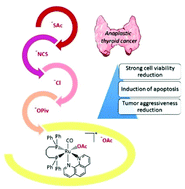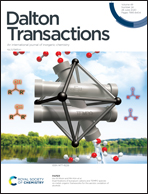Cationic carboxylate and thioacetate ruthenium(ii) complexes: synthesis and cytotoxic activity against anaplastic thyroid cancer cells†
Abstract
The cationic acetate ruthenium complex [Ru(η1-OAc)(CO)(dppb)(phen)]OAc (1) is easily prepared in 83% yield from [Ru(η1-OAc)(η2-OAc)(CO)(dppb)] (dppb = 1,4-bis(diphenylphosphino)butane) and 1,10-phenanthroline (phen) in MeOH. The derivative 1 undergoes easy substitution of the coordinated acetate by reaction with NaOPiv, KSAc, and KSCN in MeOH, affording the corresponding complexes [RuX(CO)(dppb)(phen)]X (X = OPiv, 2; SAc, 3; and NCS, 4), whereas its reaction with NaCl and NH4PF6 affords [RuCl(CO)(dppb)(phen)]PF6 (5). Carboxylate complexes 1 and 2 show high solubility in water, enabling easy exchange of the coordinated carboxylate by water and other ligands (CH3CN, glutathione). Cationic complexes 1–5, compared to Cisplatin, display a strong cell viability decrease in two human anaplastic thyroid cancer cell lines (SW1736 and 8505C), ranging from 3.10 μM to 0.09 μM EC50 values. The most active compounds 1–3 show a marked increment of apoptosis and decrease of cancer cell aggressiveness, making them promising candidates for further evaluation studies.



 Please wait while we load your content...
Please wait while we load your content...